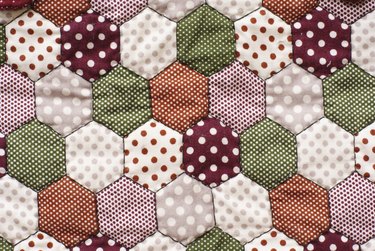
If you're top-stitching seams or quilting across a block, you can't keep the thread from showing -- especially if you're working across multiple colors of fabric, in which case no single thread color will match every piece of fabric. If you use "invisible" monofilament sewing thread, however, the transparent thread blends right into the background -- showcasing the results of the stitching without drawing your eye to the stitches themselves. Invisible thread has a reputation for breaking and snarling but, if managed carefully, can still provide beautiful results.
Choosing Your Thread
Video of the Day
As counterintuitive as it might seem, invisible thread comes in several shades. For light-colored fabrics or a mix of lights and darks, use the clear version. If you're working across lots of darker fabrics, however, the "smoke" tones may blend in better.
Video of the Day
You'll also have to choose between nylon and polyester threads. As a general rule, polyester thread stands up better to ironing, direct sunlight and high-heat settings in the dryer. Some crafters, however, still prefer nylon because they say it produces better-looking stitches.
Managing Invisible Thread
Where you put your invisible thread matters. Generations Quilt Patterns recommends placing straight-wound spools, on which every layer of thread is parallel, on your machine's vertical spool pin. Cross-wound cones, on which the layers of thread form "X"s across the spool, should go on a metal thread stand that stands beside your machine. This keeps the thread from twisting as it comes off the spool, which in turn reduces breakage. Some machines have an extra metal loop on the top back of the machine, just above the hand wheel, that functions as an extra guide for thread coming off a separate stand.
Adjusting Top Tension
High-quality invisible thread breaks so easily for a reason: If it didn't, it could cut through the fabric you're sewing like razor wire. Minimize breakage by choosing invisible thread that feels soft and pliable in your hand, with no signs of yellowing. Next, loosen your machine's stitch tension and test-stitch some swatches of the fabric you'll be quilting over. If the bobbin fabric shows on the front of the piece, loosen your stitch tension a little more; if the needle thread pulls through to the back of the piece, tighten the tension a little bit.
Choosing Bobbin Thread
It's easiest to stitch with cotton thread in the bobbin. If you do use invisible thread in the bobbin, you'll need to reduce the bobbin tension. Purchase a separate bobbin case for use only with invisible thread, so you don't have to worry about adjusting the tension back and forth in your usual bobbin case.
Thread the Needle
Use the smallest needle size possible when working with invisible thread. If you struggle to thread the needle, "color" the end of the invisible thread with a marker; then cut off that end once the needle is threaded, and you're ready to sew. When you begin stitching, make sure to lock the stitches at both the start and the end of your seams -- it'll help reduce snarls.